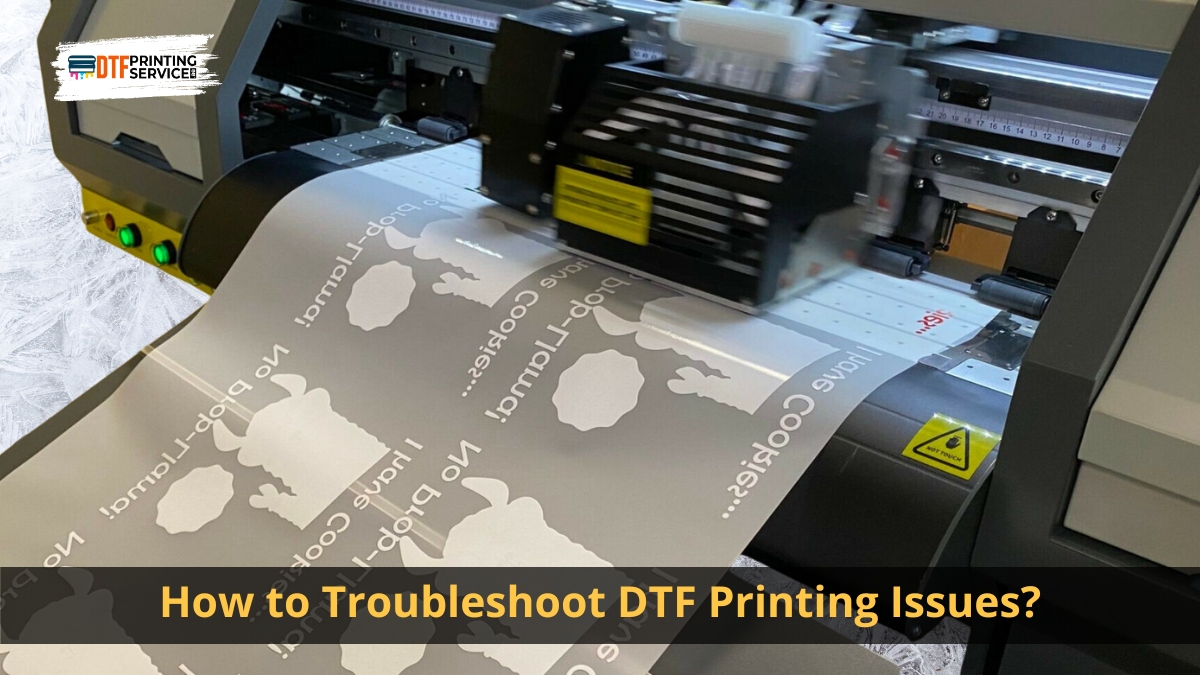Fixing DTF printing issues needs a method to find and fix problems fast. Start by inspecting the printer. Ensure calibration. Also, check for any obstructions in the print path. Next, examine the printing software settings. Troubleshoot DTF printing issues Check that they match the requirements of the printing material. Additionally, assess the film and ink quality. Make sure they are good and work together. If issues continue, check online resources. Or, get help from experienced pros in DTF printing. Remember, thorough troubleshooting leads to optimal printing results and enhances productivity.
DTF Printing Troubleshooting
DTF printing has changed the textile printing industry. It offers bright colors and detailed designs on many fabrics. Yet, like any technology, it can encounter problems that disrupt the printing process. Knowing how to troubleshoot DTF printing issues is crucial. It maintains print quality and keeps production efficient. This article provides a detailed guide. It will help you find and fix common DTF printing problems.
Understanding DTF (direct-to-film) printing
Definition and Process
DTF printing involves transferring images onto fabrics using a specialized film. The process starts with printing the desired design on a transfer film using a DTF printer. The film is then coated with adhesive powder. Cure it, then press it onto the fabric using a heat press. This method allows for vibrant and durable prints on various textiles.
Key Components
A DTF printing setup has a DTF printer and transfer film. It also has adhesive powder, a heat press, and design and printing software. Each component plays a critical role in achieving high-quality prints.
Common Uses and Applications
The fashion industry uses DTF printing. It’s for custom apparel, sportswear, promotional items, and more. Its versatility and ability to print on different fabrics make it popular. Many businesses prefer it.
Common DTF Printing Issues
Poor print quality
Poor print quality is common in DTF printing. It’s marked by fuzzy images, uneven colors, or pixelation. This problem can result from many factors. These include wrong print settings, bad inks, or mishandled film.
Inconsistent color output
Achieving consistent color output is essential for professional printing. The color variations can be due to improper calibration. They can also be due to inconsistent ink flow or factors such as temperature and humidity.
Print Head Clogging
Print head clogging is a common issue that can lead to streaks or missing lines in prints. This happens when dried ink blocks the nozzles. It’s often caused by infrequent use or low-quality inks.
Adhesion Problems
Adhesion problems occur when the print doesn’t stick to the fabric. This causes peeling or cracking. This can result from insufficient curing, improper adhesive powder application, or incompatible fabrics.
Film Jamming
Film jamming happens when the transfer film gets stuck in the printer. It disrupts the printing process.
This issue can be due to:
Incorrect film loading,
Worn-out feeding mechanisms,
Obstructions within the printer.
Ink smudging or bleeding.
Ink smudging or bleeding can ruin prints, making them look unprofessional. This issue often comes from not drying long enough. It can also come from ink and film that don’t work together, or from the wrong print settings.
Software Errors
Software errors can disrupt the printing workflow, causing delays and reducing efficiency.
These errors can come from old software, corrupted files, or it’s connection issues. They are between the printer and the computer.
Printer Calibration Issues
Proper calibration is vital for achieving accurate prints. Calibration issues can lead to misalignment, incorrect color reproduction, and poor print quality. Regular calibration checks are essential for maintaining optimal performance.
Diagnosing DTF Printing Issues
Visual Inspection
A close look at prints can reveal common problems. These include streaks, color problems, and adhesion issues. Examining the print can help identify the root cause of the problem.
Error Codes and Printer Notifications
Modern DTF printers have diagnostic tools. They show error codes and notifications. Understanding these codes can help us identify and resolve issues.
Software Diagnostics
Most DTF printers come with software. It includes tools to diagnose problems. It features tools that can check for connectivity issues. They can update firmware and run maintenance tasks. These tasks ensure that the printer is working.
Manual Troubleshooting Techniques
Sometimes, we need to troubleshoot DTF printing issues. This can involve checking the printer’s hardware. It can also involve cleaning parts or adjusting settings to improve print quality.
Resolving Print Quality Issues
Ensuring proper film and ink compatibility
Using compatible film and ink is crucial for achieving high-quality prints. Make sure the film and ink work together. They should prevent issues like smudging or poor color reproduction.
Adjusting Print Settings
The right print settings are key. They include resolution, speed, and ink density. They can affect print quality. Experimenting with different settings can help achieve the desired results.
Regular printer maintenance
Scheduling routine maintenance can prevent many common problems.
Fixing inconsistent color output is crucial. It ensures the accuracy of our visualizations.
Color Profiling and Management
Implementing a color management system ensures that colors are consistent across different prints. This involves creating and using color profiles. The profiles must match the printer, ink, and media used.
Using high-quality inks
High-quality inks are less likely to cause color inconsistencies. Invest in reputable brands that offer consistent performance and vibrant colors.
Calibration of printers and monitors
Calibrate the printer and watch it often. This makes the screen’s colors match the printed output. Calibration tools can help achieve accurate color reproduction.
Preventing print head clogging
Regular cleaning routines
Implementing regular cleaning routines for the print head can prevent clogging. You should use the built-in cleaning cycles on most printers.
Storing your printer properly
Proper storage is key for the printer. This is especially true when it’s not in use for a long time. Keep the printer in a clean, dust-free place. Turn it off to prevent ink from drying in the nozzles.
Addressing Adhesion Problems
Ensuring correct temperature and pressure
The right temperature and pressure are critical. Proper adhesion during heat transfer requires them. Refer to the manufacturer’s guidelines to ensure these settings are accurate.
Proper Use of Adhesive Powder
Ensure that you apply the adhesive powder to the printed film. Uneven application can result in poor adhesion and print durability.
Checking fabric compatibility
Not all fabrics are suitable for DTF printing. Check the fabric’s fit with DTF inks and adhesive. This check ensures good adhesion and print quality.
Solving Film Jamming Issues
Correct Film Loading Techniques
Loading the film into the printer is essential to prevent jamming. Follow the manufacturer’s instructions for proper film handling and loading.
Checking for Obstructions
Check the printer for any obstructions that might cause the film to jam. Clean the feeding mechanism and ensure it’s free of debris.
Regular maintenance of the feeding mechanism is necessary
Maintain the feeding mechanism. This includes cleaning and oiling moving parts. It’s able to prevent the film from jamming. Schedule regular checks to keep the mechanism in good working condition.
Managing ink smudges or bleeds
Drying Time and Environmental Factors
Allow adequate drying time for the printed film before handling or transferring. Humidity and temperature can affect drying times and print quality. These are environmental factors.
Correct Film and Ink Pairing
Ensure that the film and ink are compatible and designed to work together. Using the wrong combination can lead to smudging and bleeding.
Optimal Printer Settings
Adjust printer settings. Change ink density and print speed. This will reduce smudging and bleeding. Experiment with different settings to find the optimal configuration.
Dealing with software errors
Updating printer firmware and software.
Update the printer’s firmware and software to ensure compatibility and performance. Updates often include bug fixes and improvements.
Resolving connectivity issues
Make sure to connect the printer to the computer and the network. Check cables, wireless connections, and settings to resolve connectivity issues.
Reinstalling printer drivers
If software errors persist, reinstalling the printer drivers can help. Ensure that you download the latest drivers from the manufacturer’s website.
Tips for Efficient Direct-to-Film Printing
Workflow Optimization
Optimize your workflow to increase efficiency and reduce errors. This includes organizing your workspace, streamlining processes, and using automation where possible.
Best Practices for DTF Printing
Follow best practices. These include using good materials, maintaining your printer, and calibrating your equipment. They ensure consistent and high-quality prints.
Cost Management
To manage costs, use materials, and reduce waste. Maintain equipment to prevent costly repairs and downtime.
Common Mistakes to Avoid
Skipping maintenance routines
Skipping maintenance causes big issues. It also shortens your printer’s lifespan. Always follow the recommended maintenance schedule.
Ignoring printer notifications
Printer notifications often state potential problems. Ignoring these can lead to more serious issues. Addressing notifications maintains optimal printer performance.
Using substandard materials
Using low-quality materials can result in poor print quality and printer damage. You must invest in high-quality inks, films, and adhesives. This is essential to ensure the best results.
FAQs about Troubleshoot DTF printing issues
What causes streaks in DTF prints?
DTF print streaks often result from clogged print heads or incorrect settings. Low-quality ink can also cause these issues.
Regular cleaning and maintenance of the print head can help. Using high-quality materials can also help. Both can prevent streaks.
How can I improve the adhesion of prints on fabrics?
To improve adhesion, use the right temperature and pressure. Also, use the proper adhesive powder. And, check if the fabric is compatible with DTF printing.
What are the best practices for storing DTF inks?
Store DTF inks in a cool, dry place, away from direct sunlight and temperature extremes. Ensure you’ve sealed the containers to prevent contamination and drying out.
How often should I clean the print head?
You should clean the print head, depending on how often you use the printer. Follow the manufacturer’s guidelines for cleaning intervals. Clean after every big print run or it’s idle for a while.
Summary
Troubleshoot DTF printing issues is essential for maintaining high-quality prints and efficient production. To find and fix common problems, follow a system. First, inspect the hardware and check the software settings. Also, assess material quality. These problems include poor print quality, color inconsistencies, and adhesion issues. Regular maintenance, proper calibration, and following best practices are key. They prevent problems and improve printing. Also, knowing common mistakes to avoid and using efficient workflows help DTF printing. Remember, dealing with issues. And, taking preventive measures is crucial. They are key to achieving consistent and professional DTF prints.



